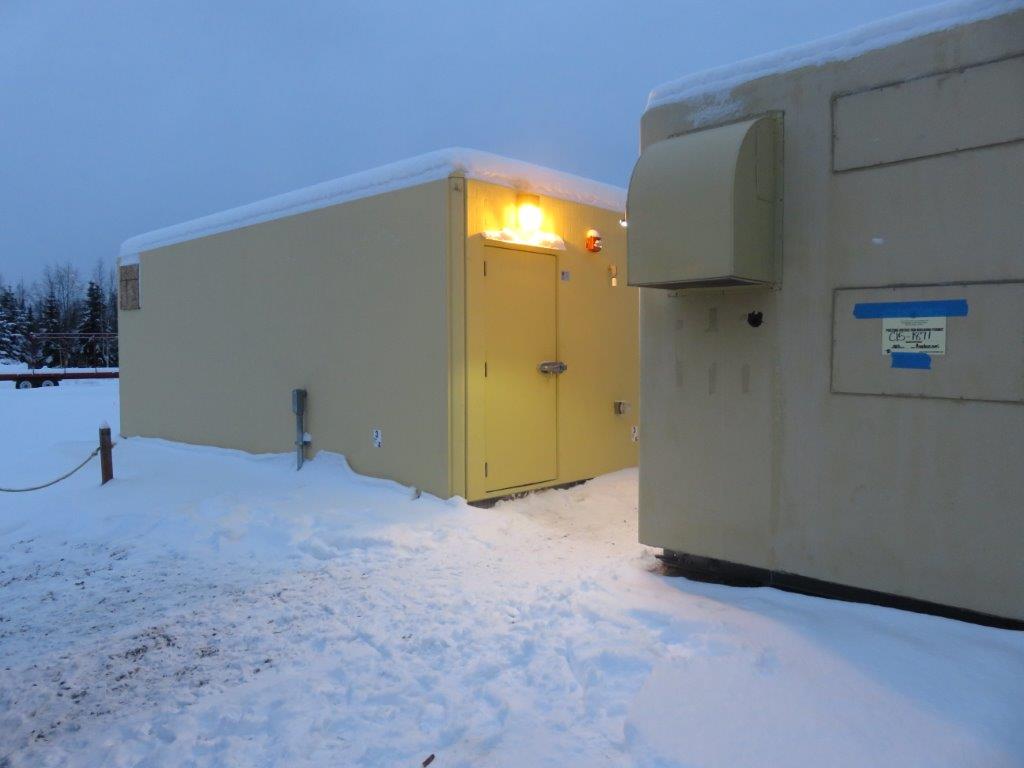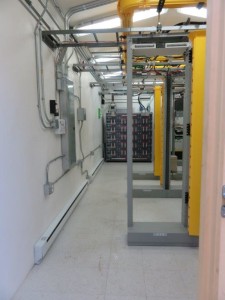Telecommunications Shelter in the Arctic Case Study
Custom Fiberglass Enclosures for Telecom Applications

GCI Communications Corporation is the largest telecom carrier in Alaska, providing wired phone service, cellular, Internet, cable TV, and data systems for the state. The recently required a telecommunications shelter engineered to withstand extreme Arctic conditions and other environmental challenges for one of its projects near Anchorage, Alaska. The shelter needed to protect critical equipment, including an 8,000-pound battery plant, relay racks, cable trays, fiber optic cables, and coaxial cables. Additionally, the shelter had to meet specific aesthetic requirements to harmonize with adjacent structures.
Project Requirements:
GCI Communications specified a fiberglass telecom shelter that was not only durable and weather-resistant but also custom-engineered to meet the demands of the environment. The shelter needed to arrive ready to install to minimize site work and streamline deployment. This approach aimed to eliminate the complexities of coordinating multiple contractors for integration work, thereby enhancing project efficiency.
Customized Design and Aesthetics
The shelter was manufactured with a custom color gel coat to match the specific yellow hue of the existing infrastructure to maintain visual consistency with a neighboring natural gas pump station. The end user provided Shelter Works with paint swatches, making precise color matching easy.
Foundation Considerations for Harsh Environments
The fiberglass enclosure was designed with structural modifications to ensure it would withstand snow loads of 125 lbs. psf and the substantial weight of the battery plant. Along with the steel base skid, the shelter included a weight distribution plate in the rear section of the floor to support a load of 1,500 pounds per square foot. The walls, roof, and doors were also reinforced with 19/32" OSB to enhance structural durability and load-bearing capacity.
Optimal Operating Environment for Telecommunications Equipment
 Given the region's harsh climate, with temperatures plummeting to -20 degrees Fahrenheit and the potential for snowfall reaching 2-3 feet per day, enhanced insulation was imperative for protecting the sensitive equipment inside. The shelter was designed with 3" foam insulation (R-19) in the walls, roof, and door to provide reliable thermal protection for equipment and maintenance personnel.
Given the region's harsh climate, with temperatures plummeting to -20 degrees Fahrenheit and the potential for snowfall reaching 2-3 feet per day, enhanced insulation was imperative for protecting the sensitive equipment inside. The shelter was designed with 3" foam insulation (R-19) in the walls, roof, and door to provide reliable thermal protection for equipment and maintenance personnel.
Two 3-ton wall-mounted air conditioning units were installed to regulate internal temperature. These units operate via an environmental control system that manages temperature fluctuations by activating 6" intake and exhaust fans and a motorized damper when necessary. The air conditioning system offsets the heat generated by the equipment inside the shelter, maintaining internal temperature during warmer months.
The Arctic floor system further enhances thermal efficiency. It consists of a 3/4" T&G plywood base, a 3/4" foam layer, and a 19/32" OSB layer covered with vinyl tile. This multi-layered flooring system provides a durable thermal barrier to prevent sub-zero temperatures from transferring through the steel base to the interior floor, ensuring consistent internal conditions.
Shelter Works engineered and manufactured a telecommunications shelter delivered to meet GCI Communications Corporation's stringent requirements for structural integrity, environmental resilience, and long-term reliability. By incorporating reinforced walls, a high-performance insulation system, and advanced environmental controls, the shelter ensures the continuous operation of critical telecom infrastructure. The steel base skid and Arctic floor system further enhance thermal efficiency, protecting equipment from extreme temperature fluctuations. This project exemplifies the capability to provide tailored, durable, and aesthetically cohesive solutions for telecommunications infrastructure in extreme environments.
"We were looking for a fiberglass telecom shelter that was aesthetically pleasing, built for Alaskan winters, and included an integration package all in one. I wanted one-stop shopping. I didn’t want to get a building and then have to hire separate contractors for all the integration work that needed to be done. I’ve done that before and it slows everything down, is hard to manage, and isn’t very cost- or time-efficient. I did not want to go down that road again, so when I found that Shelter Works makes custom telecommunications shelters, I was happy."
Geofrey Pamplin, Facilities Engineer for GCI Communications Corp.

